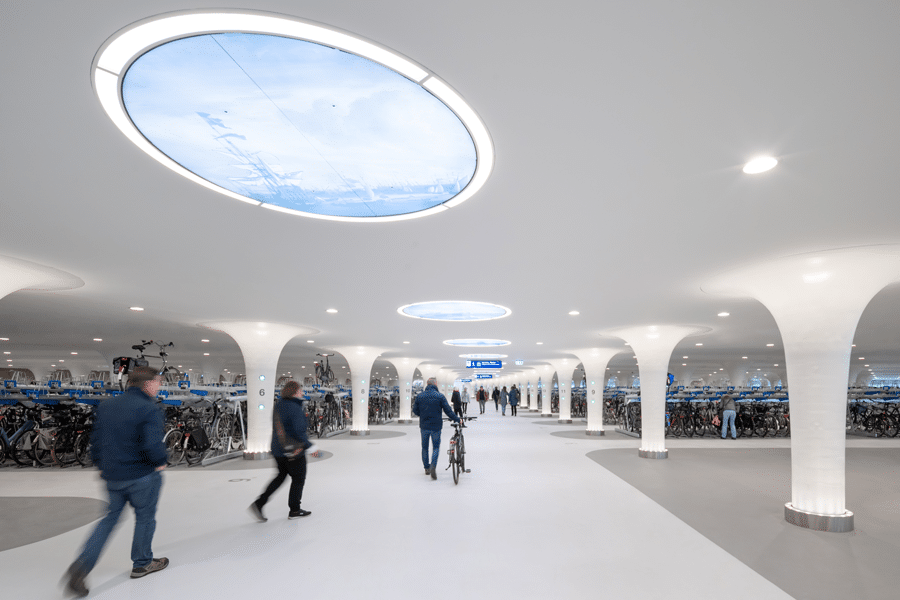When we think about cities, we typically consider the infrastructure needed to keep people in cars and taking public transportation flowing effortlessly from neighborhood to neighborhood. But there’s one city that does it differently, where bikes rule the streets and urban planning centers around two-wheeled vehicles rather than buses, trains or cars.
That city, of course, is Amsterdam. Often considered the world capital of biking, the capital of the Netherlands began a comprehensive strategy of investing in bike paths and other biking infrastructure in the 1970s. Today, the city is famous for having more bikes than residents.
Built spoke to Oriol Casas Cancer, partner-architect at wUrck studios, who just completed Amsterdam’s latest investment in “bikeability,” the world’s largest underwater bicycle parking garage, about this ambitious investment in the city’s biking future and the steps other cities need to take to follow Amsterdam’s example.
Inspired by surroundings
As Casas Cancer explained, wUrck’s bicycle parking project was only one part of a larger, ambitious renovation of Amsterdam’s iconic central station, Amsterdam Centraal.
“The bicycle parking garage is part of the De Entree project, which renewed the entire station area on the city side,” Casas Cancer said. “The garage is the first underwater bicycle parking lot in the world, and the design emphasizes its location below the water’s surface. Water was the inspiration behind many of our design decisions.”
The entrance to the parking lot is more than nine meters below the water, with tourist boats passing above the underwater entrance ramp. “To bridge the height difference, we designed a monumental entrance with high-quality materials,” Casas Cancer said. “Escalators lead the user down along a wall that is designed as a continuation of the quay wall, with a flowing shape of rugged basalt stone, and a high glass wall on the inside of the entrance space ensures that the deep-seated parking garage is still provided with daylight.”

Casas Cancer said oysters provided an unexpected source of visual inspiration for the design team. “While the materialization of the main entrance is robust and rough, the parking garage inside is a smooth, light world, with a coated cast floor and a seamless, white ceiling,” he said.
“It is a contrast reminiscent of an oyster, with its rough shell and smooth interior. Within this metaphor, the volume with the administrator’s room and the bicycle service point can be seen as the pearl in the oyster. This curved glass volume is in a central, strategic position, next to the reception area and with an overview of the entire parking garage.”
As Casas Cancer said, “What is special about this project is its location under the water. Water has therefore been made the identity carrier of the parking garage.”
The challenges of building underwater
Not only is the De Entree project the world’s first underwater bicycle parking lot; it also needed to be a lot bigger than previously constructed bicycle parking structures. While the city had been investing in bike paths since the 1970s, bicycle parking had remained somewhat scattered throughout the city.
“The enormous number of bicycles for traveling is very positive for the city, but it creates big problems in the public space around the station,” Casas Cancer said. “This is why bicycle parking lots in big city stations are generally built underground.”
With a location surrounded by water, the wUrck team needed to get creative with underwater building techniques to successfully house 7,000 of the approximately 24,000 bicycle parking spaces commuters using the Amsterdam Centraal station would need.

It was obvious that underwater building would be necessary, but it wasn’t easy. “Underwater construction is indeed highly complex,” Casas Cancer said. “To make the construction pit dry, sheet piles were driven around the excavation pit, after which the pit—with the water still in it—was excavated to 10 meters below ground level.” Once the pit was excavated, “a thick layer of unreinforced underwater concrete was poured in a continuous pour,” Casas Cancer said. “After curing, the construction pit was pumped empty.”
It was only then, after two years of preparation, that construction of the parking facility itself could begin. “A working floor was first poured on top of the underwater concrete layer, followed by a layer of reinforced concrete floor,” Casas Cancer said. “The pre-fabricated columns, together with the concrete walls, support a cast-in-place concrete roof. A waterproof finish has been applied on top of it. The interior walls are made of exposed concrete with wooden formwork. Stairs and moving walkways are covered with robust materials (natural stone, basalt and brass).”
But for Casas Cancer and his team, all this effort was worthwhile. “The parking facility has become a calling card for the city and an example of ambition for bicycle mobility,” he said. “The design goes further than just realizing a functional facility and uses the opportunity of its unique location to project the history of Amsterdam and its relationship with water.”
Inspiring a more bikeable future
As an advocate of more bikeable urban spaces, Casas Cancer hopes that the bicycle parking garage project can be a model for other cities around the world—and it all starts with making bicycle-friendly infrastructure part of the urban landscape.
“Bicycle parking lots, bridges, etc., contribute to a sustainable, healthy and livable environment and have a positive influence on mobility, traffic congestion, health and the local economy,” Casas Cancer said. “By providing cyclists with a safe and convenient storage place, our parking lot contributes to the promotion of cycling as a sustainable and healthy means of transport. This leads to less car traffic and an improvement in road safety for all road users, and to a reduction in CO2 emissions and air pollution.”

Ultimately, Casas Cancer said that projects like wUrck’s underwater bicycle parking garage need to be part of a larger cultural conversation.
“It starts by changing the cultural mindset of the specific society of the city’s inhabitants,” he said. “In some cities, the bicycle is only used for recreation. In countries like the Netherlands the bicycle is also used as a main transportation system, or to transfer to public transportation.”
How do we shift this mindset? Casas Cancer said it begins with urban planning.
“The first step is to slowly substitute the space of the car for a good bicycle paths network well connected to the public transportation and parking hubs. Cities must facilitate the network combined with relatively cheap bike-sharing facilities and safe parking facilities,” he said. “People will increase the use of these sustainable transportation systems if they are efficient and comfortable.”












